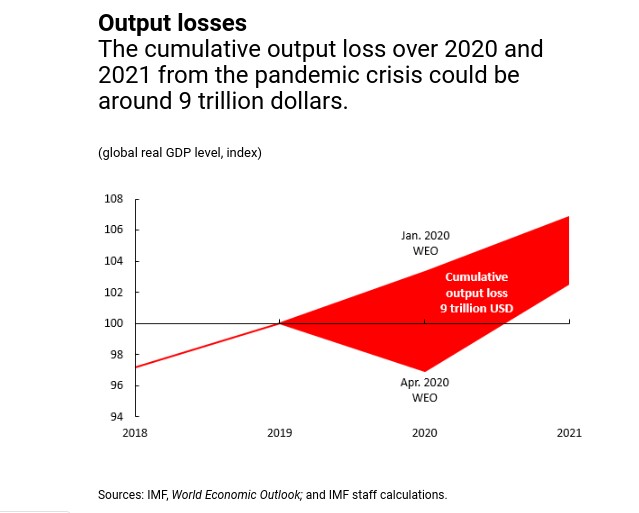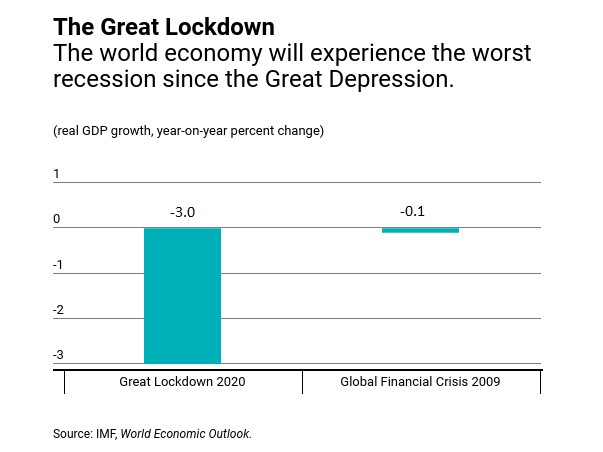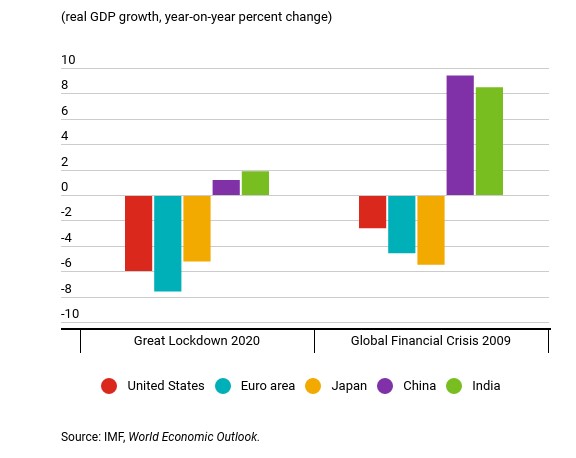Will Bitcoin Survive? IMF Predicts Worst Economy Since "Great Depression" in Aftermath of COVID-19 Global Lockdown
The International Monetary Fund (IMF) has released its quarterly World Economic Outlook for 2020 which paints a bleak picture on how the disruptive economic effects of the COVID-19 virus global quarantine measures, dubbed the ‘Great Lockdown’—will continue to cripple the markets long after the pandemic ends.
Not yet fulfilling its anticipated safe haven status is Bitcoin, which has, in fact, shown an increasingly strong correlation with the traditional markets. Although some experts believe that the COVID-19 market crash has reduced the risk of a halving price dump and could lead to a Bitcoin bull run, the data presented by the IMF indicates that the pioneer cryptocurrency will need to make a much cleaner break away from the stock markets to rally in price in the aftermath of the lockdown.

Great Lockdown Effects Difficult To Predict
The IMF has predicted that a total of nine trillion dollars will bleed out of the market by 2022 according to the 2nd quarter World Economic Outlook report released on April 14.
The April edition of the report, describes the decline in economic growth instigated by the COVID-19 global isolation and quarantine measures as the worst economic downturn since the Great Depression almost one hundred years ago.

As the current market crisis is an abnormality and brought on by an unforseen crisis in the Coronavirus pandemic, Chief Economist and Director of IMF's Research, Gita Gopinath highlighted that much of the future predictions hinge on coming possibilities. She wrote, “This is a crisis like no other, and there is substantial uncertainty about its impact on people’s lives and livelihoods. A lot depends on the epidemiology of the virus, the effectiveness of containment measures, and the development of therapeutics and vaccines, all of which are hard to predict.”
Gopinath added to this statement expressing that the supports being engineered by world government are helpful but there will be consequences to the extreme financial crisis relief efforts. She said,“Policymakers are providing unprecedented support to households, firms, and financial markets, and, while this is crucial for a strong recovery, there is considerable uncertainty about what the economic landscape will look like when we emerge from this lockdown.”
6.3% Drop in Growth Prediction
Since the January edition of the report, growth estimates have fallen by more than six percent. The latest edition now predicts that over 170 countries will experience a three percent a year-over-year retraction of economic activity and recession.
The IMF Chief Economist said, “This makes the Great Lockdown the worst recession since the Great Depression, and far worse than the Global Financial Crisis.”

Gopinath reiterated that the growth forecast was based upon a “major revision over a very short period” and the predictions are based on the assumption that the pandemic containment will peak this 2nd quarter and recede in the second half of the year.
The Global Financial Crisis led to a global growth retraction of around a tenth of a percentage in the twelve months following the 2008 market crash. The COVID disruption has made an immediate and significant impact on the GDP of China and India. 
What Do the IMF Predictions mean for the Bitcoin Price and the Halving?
The IMF’s predicted outlook for the global economy is daunting and there are concerns that Bitcoin and the cryptocurrency markets will continue their strong correlation with the S&P 500 and depreciate along with traditional assets.
According to research from Bitmex, the aftermath of the current Coronavirus market crash and the subsequent incoming inflation that will be caused by the response of the Federal Reserve and Central banks may allow Bitcoin to face its truest test and be presented its biggest opportunity to finally prove itself as a safe haven asset and may even become the foundation for our new economy.
The next big event for the crypto community is the Bitcoin halving, which is expected to take place in May 2020. Each time a Bitcoin halving takes place, the number of Bitcoins entering circulation every 10 minutes, will fall to half, to 6.25 from 12.5. As supply of the crypto decreases, the demand most likely will stay the same, but should theoretically lead to an increase in Bitcoin’s price. Experts believe that there will be less Bitcoin available in the market as the miners will be selling less of the cryptocurrency.
Bitcoin’s previous halvings have been followed by crypto bull runs, however the immediate liquidity crisis, apparent in the market, currently appears to have driven confluence across most asset classes and Bitcoin has not yet been able to break away - which will be a critical factor if we expect it to produce the anticipated post-halving bull trend.
Although Bitcoin is currently showing its strongest correlation to legacy safe haven assets like Gold and experts in the industry still believe that the pioneer crypto may have the intrinisic features to become a non-correlating asset, unfortunately its market actions have not revealed this status to be the case just yet.

